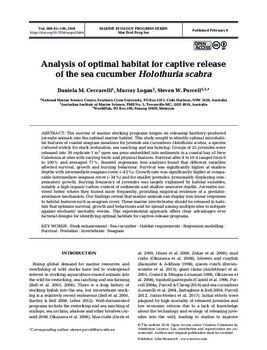Please use this identifier to cite or link to this item:
https://hdl.handle.net/20.500.12348/692
Analysis of optimal habitat for captive release of the sea cucumber Holothuria scabra
| dc.creator | Ceccarelli, D.M. | |
| dc.creator | Logan, M. | |
| dc.creator | Purcell, S.W. | |
| dc.date.accessioned | 2018-09-09T21:12:31Z | |
| dc.date.available | 2018-09-09T21:12:31Z | |
| dc.date.issued | 2018 | |
| dc.identifier | 4235.pdf | |
| dc.identifier.citation | Marine Ecology Progress Series, 588:85-100 [open access] | |
| dc.identifier.issn | 0171-8630 | |
| dc.identifier.uri | https://hdl.handle.net/20.500.12348/692 | |
| dc.description.abstract | The success of marine stocking programs hinges on releasing hatchery-produced juvenile animals into the optimal marine habitat. This study sought to identify optimal microhabitat features of coastal seagrass meadows for juvenile sea cucumbers Holothuria scabra, a species cultured widely for stock restoration, sea ranching and sea farming. | |
| dc.format | application/pdf | |
| dc.language | En | |
| dc.publisher | Inter-Research | |
| dc.source | Marine Ecology Progress Series | |
| dc.title | Analysis of optimal habitat for captive release of the sea cucumber Holothuria scabra | |
| dc.type | Journal Article | |
| dcterms.bibliographicCitation | Ceccarelli, D.M.; Logan, M.; Purcell, S.W. (2018). Analysis of optimal habitat for captive release of the sea cucumber Holothuria scabra. Marine Ecology Progress Series, 588:85-100 | |
| dc.description.version | Peer Review | |
| cg.contributor.crp | Fish | |
| cg.contributor.funder | ACIAR | |
| cg.identifier.worldfish | 4226 | |
| cg.subject.agrovoc | sea cucumbers | |
| cg.subject.agrovoc | stocking | |
| cg.subject.worldfish | sea grass | |
| cg.contributor.affiliation | Southern Cross University | |
| cg.contributor.affiliation | Australian Institute of Marine Science | |
| cg.contributor.affiliation | WorldFish | |
| cg.identifier.status | Open access | |
| cg.identifier.ISIindexed | ISI indexed | |
| cg.contribution.worldfishauthor | Purcell, S.W. | |
| cg.description.theme | Resilient small-scale fisheries | |
| dc.identifier.doi | https://doi.org/10.3354/meps12444 | en_US |
| cg.identifier.url | https://doi.org/10.3354/meps12444 |
